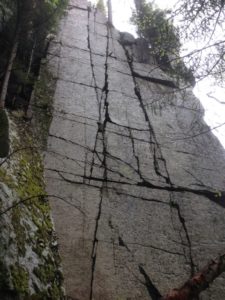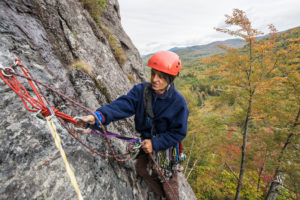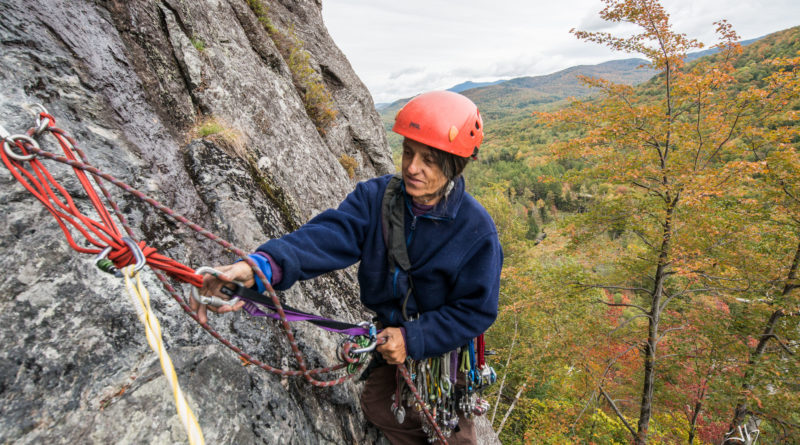Where to Climb Now?
By Emma Cotton and Zak Keene
For a week in September (Sept. 12-20), Vermont’s climbing community comes together for the Vermont Climbing Festival, a week of small group climbs, clinics, competitions and virtual speakers including climbing legends such as Ron Kauk and Pete Whittaker (the first person to free-solo El Capitan in a day).
While Vermont’s granite crags may not equal Yosemite’s walls, it has a fiercely loyal following. “I love climbing in Vermont,” says Kris Fiore, president of the Climbing Resources Access Group of Vermont (CRAG-VT). “The climbing here is scrappy and sometimes dirty—and it takes some finding. But I travel to climb all around the country, and I’m never sad to come home and climb.”
On a national scale, participation in rock climbing has exploded in the last decade. According to Climbing Business Journal, 4.6 million people participated in sport climbing, bouldering or indoor climbing in 2016. Today, that number has increased exponentially, and with that increase comes the challenge of getting people to use these climbing areas responsibly.
“We’re seeing trails more beaten out and parking lots get full,” says Fiore. “When I go to the crag, there are more people than there used to be. It’s anecdotal, but climbers get good at climbing in the gym, and they want to go outside and see what it’s all about.”
Several climbing gyms have reopened now with Covid-19 precautions in place and offer belaying lessons, fitness classes and guiding services to get you ready for an adventure. In Burlington, visit MetroRock, home to the state’s tallest walls and PetraCliffs. PetraCliffs also offers professional guiding services for all types of mountaineering, plus lessons, classes and camps. In Rutland and Quechee, the Green Mountain Rock Climbing Centers are closed for indoor climbing but are offering outdoor guided sessions. In Brattleboro, the bouldering gym, the BrattCave just reopened for weekend climbing.
And as the climbing community grows, members of CRAG-VT, the official keepers of Vermont’s crags, continue to expand access to the state’s best outdoor climbing Lone Rock Point, a 55-foot limestone cliff in Burlington looking out over Lake Champlain opened in 2017 and Bolton Dome, the 250-foot cliff in 2019.

Both Bolton Dome and Smuggler’s Notch are well-known entities and where most Vermont climbers get their start. But there are plenty of other places to check out.
If and when you decide to take the leap from the gym to the outdoors, proceed with caution. The world of outdoor climbing is not a controlled environment; there are objective hazards, unstable rock and dangers that you don’t find in an indoor climbing gym. Be safe, be cautious, and as always, be courteous.
To really discover Vermont’s best climbing, hire a guide and consult Tough Schist, Travis Peckham’s guidebook for the state (also available as an app, at vermontrock.com). Mountain Project, an online guidebook, is another fantastic resource (mountainproject.com).
NORTHEAST KINGDOM
“In Vermont, Lake Willoughby is one of the top ice climbing destinations in the country,” says Alden Pellet, who has made a number of Vermont’s first ascents and is considered one of the region’s most respected climbers. But that region is just as sweet in the fall.
Wheeler Mountain is what CRAG-VT calls a “crown jewel” of Vermont climbing—granite with lots of cracks. Mount Hor offers multi-pitch climbs for experts. Practice your slab climbing on the south-facing Bald Hill, one of the most remote crags in the state, with routes that range from a beginner’s 5.6 to an expert’s 5.10.
Black Mountain, outside the town of Norton in the northeasternmost corner of the state, is one of the newest and more remote climbing areas in Vermont. Development only began here in the last few years and there is still endless potential on this vast cliff.
Fractured granite faces, riddled with cracks and tough face climbs makes this an attractive destination for the aspiring intermediate or the thirsty expert. Quality routes which range from 5.8 to hard 5.11 decorate the lower walls. However, there are, as yet, few beginner routes to speak of at this crag and it should be approached with caution. Also, be bear aware, because they are a presence at Black Mountain! Food must be stored responsibly, and as always, leave no trace.
SMUGGLER’S NOTCH
Nestled between Stowe Mountain Resort and Smugglers Notch Resort on Route 108—the Notch’s giant schist, buttresses and hidden caves offer some of the best climbing and bouldering in New England. Climbs range from a 5.6 to a 5.14+, and the views are unbeatable. Many climbers have made the Notch their home base, including Pellett. “It’s a very mountain-like experience,” he says. Among the classics in the Notch are Quartz Crack, a featured 5.9 route with varied terrain and an airy crack traverse through a large roof at the top. A few feet to the right is a slightly smaller, but no less classic, route called The Diagonal with an exposed 5.8 right leaning crack to finish. Something else to bear in mind is that rock walls of Smuggler’s Notch are inherently unstable and a huge segment of rock slid last year. Even following a light storm, slides and rockfall are likely. Sound judgement and responsible decision making are a must for this area. Better yet, skip the bigger routes and check out the endless collection of boulders! It’s hard to run out of things to climb here, even just off the ground.
PROSPECT ROCK
Sitting astride the Long Trail in the town of Johnson is a modest bump of schist which, over the years, has been thoroughly developed. Prospect is the ideal, even the perfect location for beginning climbers, boasting a healthy variety of short, easy sport routes and a strong collection of slightly tougher trad pitches, all within short walking distance of each other. Plenty of 5.6’s to warm up on and 5.7’s, 5.8’s, 5.9’s work up to. There is something for everybody, here, and is as great a spot for families or larger groups one is likely to find. Butcher’s Crag, just a hop skip and a jump south along the Long Trail (or north, if you hike from Route 15), is a smaller cliff, but with a pleasant collection of easy to moderate sport routes, most of which can top-roped.
BOLTON
If you’re looking for beginner climbs, look no further than Lower West Bolton, located 0.4 miles up Bolton Notch Road from Route 2. “Lower West is great because there are anchors there, and there’s a path around to the top, so it’s very easy to set up a top rope,” Pellett says. “There are 30- to 40-foot climbs there that beginners can get up. That’s really where I learned to climb.”

Up the road, Upper West Bolton holds 200-foot cliffs for trad and sport climbing. The Bolton Quarry is a great spot for beginners, with a variety of grades and excellent ice climbing in the winter. For experienced climbers, try out the 82 Crag, home to Bolton’s best 5.9 and 5.10 climbs, ranging even into 5.13 territory, and spectacular views. As of spring 2019, following a 20 year closure, climbers returned, once again, to Bolton Dome – a 250-foot cliff located off Route 2, and a climber’s dream. “There’s lots of boulders there, too,” Fiore says. “It’s got a little bit of everything.” Ease of access has rendered the Dome one of the area favorites, and one of the most heavily impacted. Enjoy, but take care that the parking lot does not get overcrowded.
CENTRAL VERMONT
“There are more than 200 established bouldering problems in Groton State Forest [east of Montpelier],” says Fiore.“ If there was a good bouldering guidebook to this area, people would stop driving to the Adirondacks.” There are also good cliffs such as Marshfield Ledge, a granite cliff that rises 400 feet out of forests and wetlands, with climbing that ranges from 5.7 to 5.14. “It’s beautiful—no street noise, no cars around, excellent beginner terrain, and a pretty easy approach,” Fiore notes. Marshfield ledge was also the site of the state’s first attempts at peregrine falcon recovery. The left and right sides of the wall open in the spring. However, the main wall stays closed into August. Owl’s Head, also in Groton State Park, is a smaller cliff with steep rock and expert routes.
In Killington, just above the Inn at the Long Trail, Deer Leap hosts more than 25 routes of sport and trad climbing. If you prefer to stay closer to the ground, walk about two minutes on the Appalachian Trail near Kent Pond in Killington to the DEKD Boulders. Climb your way through the forest, with more than 80 problems already set, and many more that are currently unclimbed.
SOUTHERN VERMONT
While you’ll find most of the state’s granite, schist and limestone up north, there’s climbing to be found in southern Vermont if you look hard enough. Head to Ball Mountain Dam in Jamaica State Park to find bouldering and a few top-rope routes with easy walk-around access

